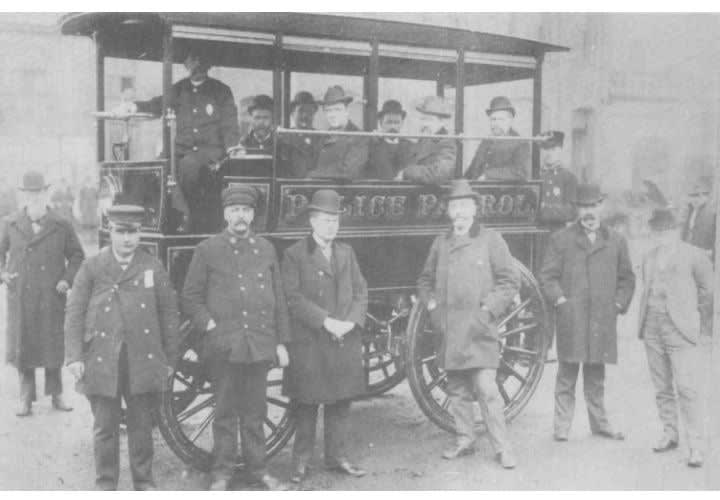Ever wonder about the first motorized patrol car used in the modern era of U.S. law enforcement?
Well, we've learned that the Akron Police Department claims this historic distinction with an electric-powered patrol wagon produced in 1899.
The Akron Police Department claims this historic distinction with an electric-powered patrol wagon produced in 1899.

The term "squad car" likely came from early patrol days, when agencies used wagons to transport the whole squad. Image via Akron Police Department.
Ever wonder about the first motorized patrol car used in the modern era of U.S. law enforcement?
Well, we've learned that the Akron Police Department claims this historic distinction with an electric-powered patrol wagon produced in 1899.
The wagon was powered by electricity fielded on the streets of Akron. On level ground, it could reach 18 mph and travel 30 miles before its battery needed to be recharged.
The vehicle was actually a buggy built by the Collins Buggy Company and designed by city mechanical engineer Frank Loomis. The $2,400 vehicle was equipped with electric lights, gongs and a stretcher.
The first operator of the patrol wagon was Akron Police officer Louis Mueller, Sr. The car's first assignment was to pick up an intoxicated man at Main and Exchange streets.
The vehicle was caught up in a race riot in Akron on Aug. 22, 1900 and pushed into the Ohio Canal. An angry mob also stormed the city jail and police facility; officers exchanged fire with the vigilantes before fleeing a building that was burned to the ground.
The wagon was rescued the following day; it served a few more years and then was junked.
By 1909, Detroit was testing modern police cars to supplement bicycle and mounted units. The cars were in response to a need to keep up with motorized vehicles driven by offenders.
In the relentless heat of summer and even early fall in some parts of the country, officers face the important task of protecting their K-9 partners while working in sweltering temperatures. Recognizing changes in a dog’s behavior is the key.
Read More →ILEETA is a complete resource for trainers to address trainers' needs. Its mission is to enhance the skills and safety of criminal justice practitioners while fostering stronger and safer communities.
Read More →Technologies for improving law enforcement training and training management were some of the highlights at this year's show.
Read More →The 2024 pursuit-rated vehicles--all pickup trucks or SUVs, including two battery electric models the Chevrolet Blazer EV AWD and Ford Mustang Mach-E--were put through their paces.
Read More →As more alternative-fuel and hybrid vehicles hit the road, police and other first responders need to understand that they are no more dangerous than conventional vehicles. However, there are certain safety considerations every cop should know.
Read More →Garmont Tactical has found wide acceptance by military boot buyers, but now the company is trying to better respond to the needs of police officers. Many cops now are not fans of 8-inch boots, so Garmont is adapting.
Read More →Through our magazine and website and our Police Technology eXchange event, we promise to provide you with information and access to resources to help you do your job safer and better.
Read More →The Harris County Sheriff's Office is a model for other agencies that want to learn about crisis intervention and mental health crisis response. Sgt. Jose Gomez shares the story of their programs and provides 10 tips for mental health crisis call response
Read More →Mike Barham, of Galco Holsters, shares five important considerations to keep in mind when you buy off-duty concealed or plain-clothes carry holsters.
Read More →While the burden of accurately reporting use-of-force situations is on an individual deputy or officer, the person reviewing those reports shares in the responsibility of making sure the reporting is done properly, with clear details included.
Read More →